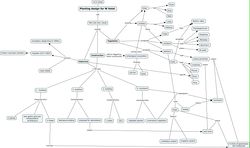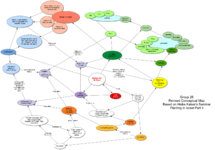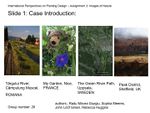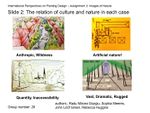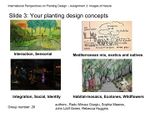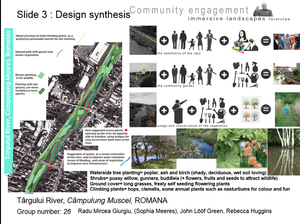Planting Design 2013 - Working Group 26: Difference between revisions
| (9 intermediate revisions by 2 users not shown) | |||
| Line 6: | Line 6: | ||
== Assignment 2 - Lecture Concept Map == | == Assignment 2 - Lecture Concept Map == | ||
<gallery caption=" " widths="250px" heights="150px" perrow="3"> | <gallery caption=" " widths="250px" heights="150px" perrow="3"> | ||
Image: | Image:lanting Israel IIinitialmap.jpeg|''This mind map looks at some of our initial ideas on which to add too, and deals with the structure and layout of the design and its historical relevance'' | ||
Image:Planting Israel II.png|''This mind map is revised and brings together our groups' opinions and key thoughts about the seminar lecture with Heike Kaiser, Planting Design in Israel pt2, where we thought also about social backdrops and design concepts'' | |||
</gallery> | </gallery> | ||
| Line 39: | Line 39: | ||
==='''[[Collaborative Design Planting Design Working Group 26|Collaborative Design Working Group 26]]'''=== | ==='''[[Collaborative Design Planting Design Working Group 26|Collaborative Design Working Group 26]]'''=== | ||
=== Presentation Slides Collaborative Design === | |||
<gallery caption=" " widths="300px" heights="300px" perrow="4"> | |||
lastpresentaiton1.png| | |||
Lastpresentation2.png| | |||
lastpresentation3.png|Discussion of four main ideas of design. 1: Swales for river infrastructure improvement and holding more run off water, brings another interesting element to the river. 2. meandering pathway, made with gravel underneath for some stability, vegetation growing through will be mown. This is best as flooding will not cause problems, and the route of the pathway can be changed with different mowing patterns. 3: Natural fence made with climbing plants for barrier of rail tracks, however is permeable and so the train line is still part of the site. 4. Perhaps most importantly bringing forward the question of community involvement. Community members could have their own patches to plant vegetables etc, they would be taught about maintenance, negative elements of the river way could be improved by them, example: by getting school children to paint, and create art on the concrete barriers running along the river. Also discussion about plants and species suitable for the river. | |||
</gallery> | |||
---- | ---- | ||
[[Category: Planting Design 2013 Working Group]] | [[Category: Planting Design 2013 Working Group]] | ||
Latest revision as of 13:17, 31 January 2014
--> Back to working group overview
Dear working group members. This is your group page and you will be completing the template gradually as we move through the seminar. Each member has an individual page for documenting his/her personal case. Good luck and enjoy your collaboration!
Assignment 2 - Lecture Concept Map
Assignment 3 - Images of Nature in your Environment
- Assigned: Wednesday, October 30
- Due: Tuesday, December 3
An 'image of nature' can be any planting design or vegetation structure. It might be on a local scale in your direct vicinity or be a part of a wider landscape structure. Each group member finds an individual page here that links to a template. You can use this template for documenting your case.
Case Study A
Case Study B
Case Study C
Case Study D
Presentation Slides Assignment 3
Assignment 4 - Collaborative Planting Design
- Assigned: Wednesday, December 4
- Due: Tuesday, January 21
Collaborative Design Working Group 26
Presentation Slides Collaborative Design
Discussion of four main ideas of design. 1: Swales for river infrastructure improvement and holding more run off water, brings another interesting element to the river. 2. meandering pathway, made with gravel underneath for some stability, vegetation growing through will be mown. This is best as flooding will not cause problems, and the route of the pathway can be changed with different mowing patterns. 3: Natural fence made with climbing plants for barrier of rail tracks, however is permeable and so the train line is still part of the site. 4. Perhaps most importantly bringing forward the question of community involvement. Community members could have their own patches to plant vegetables etc, they would be taught about maintenance, negative elements of the river way could be improved by them, example: by getting school children to paint, and create art on the concrete barriers running along the river. Also discussion about plants and species suitable for the river.
